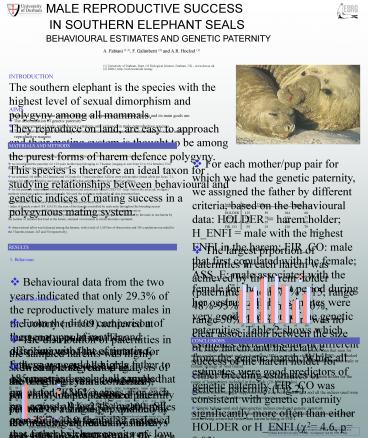Nessun titolo diapositiva - PowerPoint PPT Presentation
Title:
Nessun titolo diapositiva
Description:
male reproductive success in southern elephant seals behavioural estimates and genetic paternity a. fabiani (1,2), f. galimberti (2) and a.r. hoelzel (1) – PowerPoint PPT presentation
Number of Views:51
Avg rating:3.0/5.0
Title: Nessun titolo diapositiva
1
MALE REPRODUCTIVE SUCCESS IN SOUTHERN ELEPHANT
SEALS BEHAVIOURAL ESTIMATES AND GENETIC PATERNITY
A. Fabiani (1,2), F. Galimberti (2) and A.R.
Hoelzel (1) (1) University of Durham, Dept. Of
Biological Science, Durham, UK -
www.dur.ac.uk (2) ESRG, http//web.tiscalinet.it/e
srg/
INTRODUCTION The southern elephant is the species
with the highest level of sexual dimorphism and
polygyny among all mammals. They reproduce on
land, are easy to approach and their mating
system is thought to be among the purest forms of
harem defence polygyny. This species is therefore
an ideal taxon for studying relationships between
behavioural and genetic indices of mating success
in a polygynous mating system.
AIMS The project focuses on the southern elephant
seal population of Falkland Islands and its main
goals are v The determination of genetic
paternity v The assessment of male reproductive
strategy and variance in male reproductive
success v The evaluation of the relationships
between observational measure of male mating
success and true reproductive success
MATERIALS AND METHODS
The field work was carried out during three
breeding seasons, from 1996 to 1998 on Sea Lion
Island v we investigated the paternity for 192
pairs mother/pup belonging to 7 harems (ranging
in size from 23 to 104 females). Five harems were
from the 1996 and 2 from the 1997 v we screened
104 males, 162 females and 192 pups for 7
microsatellites. All loci were polymorphic (mean
allele per locus 7.1, range 4-10) and amplified
for one locus, except BETA that amplifies for two
loci (and four alleles) v for the paternity
inference we tested both exclusion and
statistically based (CERVUS - http//helios.bto.ed
.ac.uk/ evolgen/) methods which gave almost
identical results. We used the exclusion method
for all data presented here. v we estimated 3
behavioural indices of breeding success for each
male - index of female control (FF_DAYS) the
sum of the females controlled by each male
throughout the breeding season - index of mating
success (MS100) the number of copulations by the
male in 100 hours of observation - index of
fertilization success (ENFI), the product between
the proportion of copulations achieved by the
male in one harem by the number of females that
bred in the harem, summed over harems in which
the male copulated v observational effort was
balanced among the harems, with a total of 1,030
hrs of observation and 356 copulations recorded
for the 7 harems (means 147 and 50 respectively).
v For each mother/pup pair for which we had the
genetic paternity, we assigned the father by
different criteria, based on the behavioural
data HOLDER harem holder H_ENFI male with
the highest ENFI in the harem FIR_CO male that
first copulated with the female ASS_E male
associated with the female for the longest period
during her oestrus. All the estimates were very
good predictors of the genetic paternities. Table
2 shows which estimates were the same or
different from the genetic match. While all
estimates were good predictors of genetic
paternity, FIR_CO was consistent with genetic
paternity significantly more often than either
HOLDER or H_ENFI (?2 4.6, p 0.03).
Index Same Differ.
n same HOLDER 125 59 184 68 ASS_E 115
38 153 75 H_ENFI 125 59 184 68 FIR_CO
95 25 120 79
Table 2
v The largest prportion of paternities in each
harem was achieved by the harem holder
(paternities mean 72 15, range 48-95 ENFI
mean 80, range 50-100). There was no clear
association between the size of the harem and the
relative success of the harem holder for either
breeding estimates or genetic paternity (Fig.2).
RESULTS
1. Behaviour v Behavioural data from the two
years indicated that only 29.3 of the
reproductively mature males in the colony (n109)
achieved at least one copulation. The
distributions of the estimates for both years
were all highly asymmetric, even among males that
copulated (ENFI means respectively 9.623.5 for
109 males and 32.733.9 for the 32 males that
copulated opportunity of selection I 6.12).
Fig.2
CONCLUSIONS
v The average success of harem holders (72 of
paternities) was greater than that seen for
either southern elephant seals in Argentina (58)
or northern elephant seals (38 see Hoelzel et
al. 1999, Behav. Ecol. Sciobiol. 46298-306),
which may imply a difference in either male or
female strategy at Seal Island. v There was no
correlation between harem size and the success of
the harem holder for the range of harem sizes
included in this study (20-104 females). v
Genetic results strongly supported those from
behavioural data and all the indices used were
good predictors of the relative male reproductive
success. v Simple behavioural and demographic
indices predicted genetic paternity 68-79 of
the time, with behaviours associated with first
copulation and association during oestrus being
somewhat better than harem holding or ENFI.
Fig.1
Special thanks to all the people who worked in
the field with us. Funding to A. Fabiani from the
University of Rome, La Sapienza and the CNR of
Italy.































